All Exams >
Civil Engineering (CE) >
RRB JE for Civil Engineering >
All Questions
All questions of RCC & Prestressed Concrete for Civil Engineering (CE) Exam
A rectangular beam of 500mm × 800mm with an effective cover of 40 mm is subjected to a factored shear force 30 KN, a bending moment of 100 KN - m and a torsional moment of 15 KN - m. The design bending moment in KN - m for the beam will be ________(Use shear resistance of the cross-section τc is 0.48 MPa)- a)100
- b)123
- c)77
- d)None
Correct answer is option 'A'. Can you explain this answer?
A rectangular beam of 500mm × 800mm with an effective cover of 40 mm is subjected to a factored shear force 30 KN, a bending moment of 100 KN - m and a torsional moment of 15 KN - m. The design bending moment in KN - m for the beam will be ________
(Use shear resistance of the cross-section τc is 0.48 MPa)
a)
100
b)
123
c)
77
d)
None

|
Ritika Menon answered |
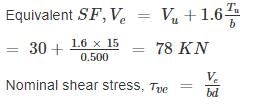

= 0.205 N/mm2 < τc
So the design bending moment will be, Mu = 100 KN - m.
A rectangular beam of width b = 250 mm, effective depth d = 350 mm is reinforced in tension with mild steel of grade Fe250, Ast = 1800 mm2. The grade of concrete used is M30. The ultimate moment of resistance of the beam is ________- a)113 kN-m
- b)137 kN-m
- c)320 kN-m
- d)432 kN-m
Correct answer is option 'A'. Can you explain this answer?
A rectangular beam of width b = 250 mm, effective depth d = 350 mm is reinforced in tension with mild steel of grade Fe250, Ast = 1800 mm2. The grade of concrete used is M30. The ultimate moment of resistance of the beam is ________
a)
113 kN-m
b)
137 kN-m
c)
320 kN-m
d)
432 kN-m

|
Sahana Dey answered |
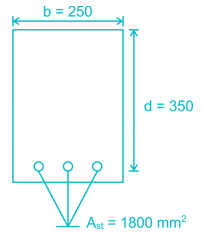
Xu,max = 0.53 d= 0.53 × 350 = 185.5 mm
Calculating actual neutral axis of the beam
0.36 fck b Xu = 0.87 fy Ast


= 145 mm < xu,max
∴ Under reinforced section.
∴ Moment of resistance,
Mu = 0.87 fy Ast (d – 0.42 xu)
= 0.87 × 250 × 1800 (350 – 0.42 × 145)
= 113.182 × 106 N – mm
= 113.182 kN-m
An axially loaded column is of 400 mm × 500 mm size. The effective length of the column is 4 m. What is the minimum eccentricity of the axial load for the column along shorter and longer side respectively?- a)21.33 mm and 24.67 mm
- b)20 mm and 24.67 mm
- c)21.33 mm and 20 mm
- d)20 mm and 20 mm
Correct answer is option 'A'. Can you explain this answer?
An axially loaded column is of 400 mm × 500 mm size. The effective length of the column is 4 m. What is the minimum eccentricity of the axial load for the column along shorter and longer side respectively?
a)
21.33 mm and 24.67 mm
b)
20 mm and 24.67 mm
c)
21.33 mm and 20 mm
d)
20 mm and 20 mm

|
Shail Rane answered |
As per IS 456:2000, minimum eccentricity equals to unsupported length of column/500 plus lateral dimension/30, subject to minimum of 20 mm.
In this case:  along shorter side
along shorter side
 along shorter side
along shorter sideAnd  mm along longer side.
mm along longer side.
 mm along longer side.
mm along longer side.If after 28 days of the casting of RC beam, the creep strain is 60% more than that of Elastic strain Percentage decrease in modulus of elasticity according to IS 456 : 2000 is- a)160%
- b)58%
- c)60%
- d)61.5%
Correct answer is option 'D'. Can you explain this answer?
If after 28 days of the casting of RC beam, the creep strain is 60% more than that of Elastic strain Percentage decrease in modulus of elasticity according to IS 456 : 2000 is
a)
160%
b)
58%
c)
60%
d)
61.5%

|
Navya Saha answered |
Modulus of Elasticity concrete
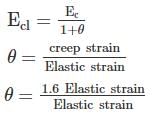
θ = 1.6

% decrease = 61.5%

θ = 1.6

% decrease = 61.5%
Which one of the following Mineral is required for muscle contraction ?- a)Calcium
- b)Iron
- c)Sodium
- d)Zinc
Correct answer is option 'A'. Can you explain this answer?
a)
Calcium
b)
Iron
c)
Sodium
d)
Zinc

|
G.K Academy answered |
Mineral required for muscle contraction:
Answer: A. Calcium
Explanation:
Muscle contraction is a complex process that requires the involvement of various minerals and ions. Among these, calcium plays a crucial role in initiating and regulating muscle contractions. Here's a detailed explanation:
1. Importance of Calcium:
- Calcium is an essential mineral for many bodily functions, including muscle contraction.
- It is required for the interaction between actin and myosin, the proteins responsible for muscle contraction.
- Calcium ions bind to troponin, a regulatory protein, allowing actin and myosin to form cross-bridges and initiate muscle contraction.
2. Muscle Contraction Process:
- When a muscle receives a signal from the nervous system, it undergoes a series of events to contract.
- The signal triggers the release of calcium ions from the sarcoplasmic reticulum, a specialized structure within muscle cells.
- The released calcium ions bind to troponin, causing a conformational change in the troponin-tropomyosin complex.
- This conformational change exposes the binding sites on actin, allowing myosin heads to attach and form cross-bridges.
- The interaction between actin and myosin leads to the sliding of muscle filaments, resulting in muscle contraction.
3. Other Minerals:
- While calcium is the primary mineral involved in muscle contraction, other minerals also play important roles.
- Sodium and potassium ions are involved in generating the electrical impulses that initiate muscle contractions.
- Iron is essential for oxygen transport and energy production in muscles, but it does not directly participate in the contraction process.
- Zinc is involved in various enzymatic reactions and overall muscle health but is not directly involved in muscle contraction.
In conclusion, calcium is the mineral required for muscle contraction. It is involved in the regulation and initiation of muscle contractions by allowing actin and myosin to interact.
Answer: A. Calcium
Explanation:
Muscle contraction is a complex process that requires the involvement of various minerals and ions. Among these, calcium plays a crucial role in initiating and regulating muscle contractions. Here's a detailed explanation:
1. Importance of Calcium:
- Calcium is an essential mineral for many bodily functions, including muscle contraction.
- It is required for the interaction between actin and myosin, the proteins responsible for muscle contraction.
- Calcium ions bind to troponin, a regulatory protein, allowing actin and myosin to form cross-bridges and initiate muscle contraction.
2. Muscle Contraction Process:
- When a muscle receives a signal from the nervous system, it undergoes a series of events to contract.
- The signal triggers the release of calcium ions from the sarcoplasmic reticulum, a specialized structure within muscle cells.
- The released calcium ions bind to troponin, causing a conformational change in the troponin-tropomyosin complex.
- This conformational change exposes the binding sites on actin, allowing myosin heads to attach and form cross-bridges.
- The interaction between actin and myosin leads to the sliding of muscle filaments, resulting in muscle contraction.
3. Other Minerals:
- While calcium is the primary mineral involved in muscle contraction, other minerals also play important roles.
- Sodium and potassium ions are involved in generating the electrical impulses that initiate muscle contractions.
- Iron is essential for oxygen transport and energy production in muscles, but it does not directly participate in the contraction process.
- Zinc is involved in various enzymatic reactions and overall muscle health but is not directly involved in muscle contraction.
In conclusion, calcium is the mineral required for muscle contraction. It is involved in the regulation and initiation of muscle contractions by allowing actin and myosin to interact.
A floor slab of thickness t is cast monolithically transverse to a rectangular continuous beam of span L and width B. If the distance between two consecutive points of contra flexure is, L0, the effective width of compression flange at continuous support is- a)B
- b)L/3
- c)B + 12 t
- d)bw + 6df + L0/6
Correct answer is option 'D'. Can you explain this answer?
A floor slab of thickness t is cast monolithically transverse to a rectangular continuous beam of span L and width B. If the distance between two consecutive points of contra flexure is, L0, the effective width of compression flange at continuous support is
a)
B
b)
L/3
c)
B + 12 t
d)
bw + 6df + L0/6

|
Rounak Banerjee answered |
**Given:**
- Thickness of floor slab, t
- Span of rectangular continuous beam, L
- Width of rectangular continuous beam, B
- Distance between two consecutive points of contraflexure, L0
**To find:**
The effective width of compression flange at continuous support
**Solution:**
The effective width of the compression flange at continuous support can be determined using the concept of the plastic moment capacity of the beam. The plastic moment capacity of a beam is given by the product of the plastic section modulus and the yield strength of the material.
The plastic section modulus of a rectangular beam can be calculated as:
Z = (B x t^2) / 6
The plastic moment capacity of the beam is given by:
Mp = Z x Fy
where Fy is the yield strength of the material.
To calculate the effective width of the compression flange at continuous support, we need to find the distance between two consecutive points of contraflexure, L0.
The distance between two consecutive points of contraflexure, L0, is given by:
L0 = (bw^2) / (6 x df)
where bw is the effective width of the compression flange and df is the depth of the beam.
Rearranging the equation, we get:
bw = (6 x df x L0) / bw^2
Substituting the values of L0, df, and bw, we get:
bw = (6 x t x L) / (6 x t) = L
Therefore, the effective width of the compression flange at continuous support is L, which is given by option D.
- Thickness of floor slab, t
- Span of rectangular continuous beam, L
- Width of rectangular continuous beam, B
- Distance between two consecutive points of contraflexure, L0
**To find:**
The effective width of compression flange at continuous support
**Solution:**
The effective width of the compression flange at continuous support can be determined using the concept of the plastic moment capacity of the beam. The plastic moment capacity of a beam is given by the product of the plastic section modulus and the yield strength of the material.
The plastic section modulus of a rectangular beam can be calculated as:
Z = (B x t^2) / 6
The plastic moment capacity of the beam is given by:
Mp = Z x Fy
where Fy is the yield strength of the material.
To calculate the effective width of the compression flange at continuous support, we need to find the distance between two consecutive points of contraflexure, L0.
The distance between two consecutive points of contraflexure, L0, is given by:
L0 = (bw^2) / (6 x df)
where bw is the effective width of the compression flange and df is the depth of the beam.
Rearranging the equation, we get:
bw = (6 x df x L0) / bw^2
Substituting the values of L0, df, and bw, we get:
bw = (6 x t x L) / (6 x t) = L
Therefore, the effective width of the compression flange at continuous support is L, which is given by option D.
The reduction coefficient of a reinforced concrete column with an effective length of 4.8 m and size 250 mm × 300 mm is- a)0.80
- b)0.85
- c)0.90
- d)0.95
Correct answer is option 'B'. Can you explain this answer?
The reduction coefficient of a reinforced concrete column with an effective length of 4.8 m and size 250 mm × 300 mm is
a)
0.80
b)
0.85
c)
0.90
d)
0.95

|
Gitanjali Menon answered |
It is not possible to determine the reduction coefficient of a reinforced concrete column with just the given information of effective length and size. The reduction coefficient depends on several other factors such as the type of reinforcement used, the concrete strength, and the loading conditions.
A plain concrete footing made of M20 concrete is subjected to uniform pressure of 7 Mpa. Its total depth is 700 mm, the permissible maximum projection beyond the face of the column is ________- a)700 mm
- b)323 mm
- c)130 mm
- d)45 mm
Correct answer is option 'C'. Can you explain this answer?
A plain concrete footing made of M20 concrete is subjected to uniform pressure of 7 Mpa. Its total depth is 700 mm, the permissible maximum projection beyond the face of the column is ________
a)
700 mm
b)
323 mm
c)
130 mm
d)
45 mm

|
Deepika Saha answered |
fck = 20 MPa
D = 700 mm
qo = 7 Mpa

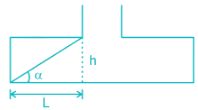
∴ tan α = 700/L ⇒ L = 129.6 ≃ 130mm


∴ tan α = 700/L ⇒ L = 129.6 ≃ 130mm
Consider the following statements and Identify the correct option with regard to provisions of IS 456: 2000:P. The minimum stripping time for props to slab spanning over 4.5 m is 7 daysQ. The minimum stripping time for props to arches spanning over 6 m is 14 days.R. To ensure the strength of Designed concrete mix, Random sampling procedure is adoptedS. When a bar of two different diameters is to be spliced, the lap length shall be calculated on the basis of the bar of the larger diameter.- a)P – True Q – True R – True S – False
- b)P – False Q – False R – True S – True
- c)P – True Q – False R – False S – False
- d)P – False Q – False R – True S – False
Correct answer is option 'D'. Can you explain this answer?
Consider the following statements and Identify the correct option with regard to provisions of IS 456: 2000:
P. The minimum stripping time for props to slab spanning over 4.5 m is 7 days
Q. The minimum stripping time for props to arches spanning over 6 m is 14 days.
R. To ensure the strength of Designed concrete mix, Random sampling procedure is adopted
S. When a bar of two different diameters is to be spliced, the lap length shall be calculated on the basis of the bar of the larger diameter.
a)
P – True Q – True R – True S – False
b)
P – False Q – False R – True S – True
c)
P – True Q – False R – False S – False
d)
P – False Q – False R – True S – False

|
Rajat Patel answered |
As per IS 456 : 2000,
(i) The minimum stripping time for props to slab spanning up to 4.5 m and spanning over 4.5 m is 7 days and 14 days respectively.
(ii) The minimum stripping time for props to aches spanning up to 6 m and spanning over 6 m is 14 days and 21 days respectively.
(iii) When bar of two different diameter are to be spliced the lap length shall be calculated on the basis of bar of smaller diameter.
(iv) A random sampling procedure shall be adopted to ensure that each concrete batch shall have a reasonable chance of being tested that is, the sampling should be spread over the entire period of concreting and cover all mixing units.
As per IS 456:2000, for the heavily reinforced concrete column, the nominal maximum size of aggregate should be restricted:- a)to 5 mm less than the minimum clear distance between the main bars or 5 mm less than the minimum cover to the reinforcement whichever is smaller.
- b)to 5 mm less than the minimum clear distance between the main bars or 5 mm less than the minimum cover to the reinforcement whichever is greater.
- c)to 10 mm less than the minimum clear distance between the main bars or 10 mm less than the minimum cover to the reinforcement whichever is smaller.
- d)to 10 mm less than the minimum clear distance between the main bars or 10 mm less than the minimum cover to the reinforcement whichever is greater.
Correct answer is option 'A'. Can you explain this answer?
As per IS 456:2000, for the heavily reinforced concrete column, the nominal maximum size of aggregate should be restricted:
a)
to 5 mm less than the minimum clear distance between the main bars or 5 mm less than the minimum cover to the reinforcement whichever is smaller.
b)
to 5 mm less than the minimum clear distance between the main bars or 5 mm less than the minimum cover to the reinforcement whichever is greater.
c)
to 10 mm less than the minimum clear distance between the main bars or 10 mm less than the minimum cover to the reinforcement whichever is smaller.
d)
to 10 mm less than the minimum clear distance between the main bars or 10 mm less than the minimum cover to the reinforcement whichever is greater.

|
Siddharth Bajaj answered |
As per IS 456:2000, Clause 5.3.3.1:
For Heavily reinforced concrete members as in the case of ribs of main beams, the nominal maximum size of aggregate should usually be restricted to 5 mm less than the minimum clear distance between the main bars or 5 mm less than the minimum cover to the reinforcement whichever is smaller.
For bars in tension, a standard hook has an anchorage value equivalent to a straight length of- a)8ϕ
- b)12ϕ
- c)16ϕ
- d)24ϕ
Correct answer is option 'C'. Can you explain this answer?
For bars in tension, a standard hook has an anchorage value equivalent to a straight length of
a)
8ϕ
b)
12ϕ
c)
16ϕ
d)
24ϕ

|
Anuj Verma answered |
As per IS 456: 2000,
A standard hook has an anchorage value equivalent to a straight length of 16ϕ.
The anchorage value of standard U-type hook shall be 16 times the diameter of the bar.
The anchorage value of standard bend shall be considered as 4 times the diameter of the bar for each 45o bend subject to a maximum value of 16 times the diameter of the bar.
The purpose of reinforcement in prestressed concrete is- a)to provide adequate bond stress
- b)to resist tensile stress
- c)to import initial compressive stress in concrete
- d)all of these
Correct answer is option 'C'. Can you explain this answer?
The purpose of reinforcement in prestressed concrete is
a)
to provide adequate bond stress
b)
to resist tensile stress
c)
to import initial compressive stress in concrete
d)
all of these

|
Aditi Chakraborty answered |
Prestressed concrete import initial compressive stresses to counter tensile stresses due to loading.
Reinforcement bars are placed in a form and stressed or stretched with forces on each end of bars pulling them. When concrete is poured around the stressing bonds before pressure is released, it creates tension.
When the tension is released the steel tendency to try to resume its original shape and adds a compressive force to the concrete laterally, giving it strength to span distances.
Minimum shear reinforcement in beams is provided in the form of stirrups- a)to resist extra shear force due to live load
- b)to resist the effect of shrinkage of concrete
- c)to resist principal tension
- d)to resist shear cracks at the bottom of beam
Correct answer is option 'C'. Can you explain this answer?
Minimum shear reinforcement in beams is provided in the form of stirrups
a)
to resist extra shear force due to live load
b)
to resist the effect of shrinkage of concrete
c)
to resist principal tension
d)
to resist shear cracks at the bottom of beam

|
Sarthak Kulkarni answered |
The minimum shear reinforcement is provided for the following:
(i) Any sudden failure of beams is prevented if concrete cover bursts and the bond to the tension steel is lost.
(ii) Brittle shear failure is arrested which would have occurred due to principal tension without shear reinforcement.
(iii) Tension failure is prevented which would have occurred due to shrinkage, thermal stresses and internal cracking in beams.
(iv) To hold the reinforcement in place when concrete is poured.
(v) Section becomes effective with the tie effect of the compression steel.
A simply supported beam of 300 mm wide and 500 mm deep is loaded as the shear force at support is 140 KN and throughout the beam, the SF does not exceed 70 KN. One out of six bars of 22 mm dia, Fe 415 grade is bent up at 45˚ near the support to resist the shear. Analyze the beam and choose the correct statement: - M20 grade concrete is used with τc = 0.48Mpa- a)Beam is safe in shear; no need of transverse shear reinforcement.
- b)No need of bent up bar.
- c)Beam is to be designed for transverse shear reinforcement.
- d)Section should be revised.
Correct answer is option 'A'. Can you explain this answer?
A simply supported beam of 300 mm wide and 500 mm deep is loaded as the shear force at support is 140 KN and throughout the beam, the SF does not exceed 70 KN. One out of six bars of 22 mm dia, Fe 415 grade is bent up at 45˚ near the support to resist the shear. Analyze the beam and choose the correct statement: -
M20 grade concrete is used with τc = 0.48Mpa
a)
Beam is safe in shear; no need of transverse shear reinforcement.
b)
No need of bent up bar.
c)
Beam is to be designed for transverse shear reinforcement.
d)
Section should be revised.

|
Sravya Rane answered |
Shear resisted by concrete = τc bd
= 0.48 × 300 × 500 × 10 - 3
= 72 KN > 70 KN
Now, at the support shear to be resisted by bent up bar,
Vus = Vu - τc bd = 140 - 72 = 68 KN
Shear resisted by bent up bars near supports,
Vusb = 0.87 fy Ast Sinα
Vusb = 0.87 × 415 × π/4 × 222 × sin45∘
Vusb = 0.87 × 415 × π/4 × 222 × sin45∘
= 97 KN > 68 KN
So the beam is safe in shear throughout the beam with bent up bars.
No need of transverse shear reinforcement.
A RC short column of size 460 mm × 460 mm having an effective length of 3.6 m is to be designed using LSM to support an axial service load of 2500 kNThe area of steel in compression is (M20, Fe415)- a)8618 mm2
- b)7618 mm2
- c)6618 mm2
- d)5710 mm2
Correct answer is option 'B'. Can you explain this answer?
A RC short column of size 460 mm × 460 mm having an effective length of 3.6 m is to be designed using LSM to support an axial service load of 2500 kN
The area of steel in compression is (M20, Fe415)
a)
8618 mm2
b)
7618 mm2
c)
6618 mm2
d)
5710 mm2

|
Gitanjali Menon answered |
A short column refers to a structural element that is predominantly subjected to axial compression. In the case of a reinforced concrete (RC) short column with a size of 460 mm, it means that the cross-sectional dimensions of the column are 460 mm by 460 mm.
The column size of 460 mm by 460 mm indicates the width and depth of the column. It is important to note that the dimensions mentioned here are the clear dimensions, meaning they exclude any cover or additional reinforcement.
The design and analysis of an RC short column involve considering factors such as the load applied, the material properties of concrete and reinforcement, and the column's slenderness ratio. The slenderness ratio is determined by the effective length of the column and its least lateral dimension.
For a short column, the primary design consideration is the axial load carrying capacity. This is determined by the strength of the concrete and the reinforcement. The column's capacity is typically governed by either the concrete's compressive strength or the reinforcement's yield strength, depending on which one is reached first.
To ensure the structural integrity of the column, reinforcement is typically provided to enhance the concrete's ability to resist tension and improve the column's ductility. The reinforcement is usually in the form of steel bars or mesh placed within the concrete.
The design requirements for the short column will depend on the specific project and its structural demands. Local building codes and design standards should be consulted to determine the appropriate design parameters for the column.
Overall, a short column with a size of 460 mm by 460 mm requires careful design and analysis to ensure it can withstand the applied loads and meet the required safety standards.
The column size of 460 mm by 460 mm indicates the width and depth of the column. It is important to note that the dimensions mentioned here are the clear dimensions, meaning they exclude any cover or additional reinforcement.
The design and analysis of an RC short column involve considering factors such as the load applied, the material properties of concrete and reinforcement, and the column's slenderness ratio. The slenderness ratio is determined by the effective length of the column and its least lateral dimension.
For a short column, the primary design consideration is the axial load carrying capacity. This is determined by the strength of the concrete and the reinforcement. The column's capacity is typically governed by either the concrete's compressive strength or the reinforcement's yield strength, depending on which one is reached first.
To ensure the structural integrity of the column, reinforcement is typically provided to enhance the concrete's ability to resist tension and improve the column's ductility. The reinforcement is usually in the form of steel bars or mesh placed within the concrete.
The design requirements for the short column will depend on the specific project and its structural demands. Local building codes and design standards should be consulted to determine the appropriate design parameters for the column.
Overall, a short column with a size of 460 mm by 460 mm requires careful design and analysis to ensure it can withstand the applied loads and meet the required safety standards.
A prestress concrete rectangular beam of size 300 mm × 900 mm is pre-stressed with an initial prestressing force of 700 kN at an eccentricity of 300 mm. Stress at the top beam section due to prestress alone in, N/mm2 is:- a)2.59 (compression)
- b)3.59 (compression)
- c)2.59 (tension)
- d)3.59 (tension)
Correct answer is option 'C'. Can you explain this answer?
A prestress concrete rectangular beam of size 300 mm × 900 mm is pre-stressed with an initial prestressing force of 700 kN at an eccentricity of 300 mm. Stress at the top beam section due to prestress alone in, N/mm2 is:
a)
2.59 (compression)
b)
3.59 (compression)
c)
2.59 (tension)
d)
3.59 (tension)

|
Arnab Saini answered |
X 500 mm is subjected to a service load of 100 kN. The concrete has a compressive strength of 30 MPa and the steel has a yield strength of 500 MPa. Calculate the required prestressing force to ensure that the concrete remains in compression under the service load.
To calculate the required prestressing force, we need to determine the maximum bending moment and the corresponding stress in the concrete.
The maximum bending moment (M) can be calculated using the formula:
M = (w * l^2) / 8
where w is the service load per unit length and l is the span length.
Given that the width of the beam (b) is 300 mm and the depth (d) is 500 mm, we can calculate the section modulus (S) using the formula:
S = (b * d^2) / 6
The stress in the concrete (σc) can be calculated using the formula:
σc = M / S
Finally, the required prestressing force (Fp) can be calculated using the formula:
Fp = σc * Ac
where Ac is the cross-sectional area of the concrete.
Given:
Width of the beam (b) = 300 mm
Depth of the beam (d) = 500 mm
Service load (w) = 100 kN
Span length (l) = ?
Compressive strength of concrete (fc) = 30 MPa
Yield strength of steel (fy) = 500 MPa
First, let's calculate the span length (l) using the formula:
w = (Total load) / (length)
100 kN/m = (100 kN) / (l)
l = (100 kN) / (100 kN/m)
l = 1 m
Now, let's calculate the section modulus (S) using the formula:
S = (b * d^2) / 6
S = (300 mm * (500 mm)^2) / 6
S = 25,000,000 mm^3
Next, let's calculate the maximum bending moment (M) using the formula:
M = (w * l^2) / 8
M = (100 kN/m * (1 m)^2) / 8
M = 12.5 kNm
Now, let's calculate the stress in the concrete (σc) using the formula:
σc = M / S
σc = 12.5 kNm / 25,000,000 mm^3
σc = 0.0005 MPa
Finally, let's calculate the required prestressing force (Fp) using the formula:
Fp = σc * Ac
Fp = 0.0005 MPa * (300 mm * 500 mm)
Fp = 75 kN
Therefore, the required prestressing force to ensure that the concrete remains in compression under the service load is 75 kN.
To calculate the required prestressing force, we need to determine the maximum bending moment and the corresponding stress in the concrete.
The maximum bending moment (M) can be calculated using the formula:
M = (w * l^2) / 8
where w is the service load per unit length and l is the span length.
Given that the width of the beam (b) is 300 mm and the depth (d) is 500 mm, we can calculate the section modulus (S) using the formula:
S = (b * d^2) / 6
The stress in the concrete (σc) can be calculated using the formula:
σc = M / S
Finally, the required prestressing force (Fp) can be calculated using the formula:
Fp = σc * Ac
where Ac is the cross-sectional area of the concrete.
Given:
Width of the beam (b) = 300 mm
Depth of the beam (d) = 500 mm
Service load (w) = 100 kN
Span length (l) = ?
Compressive strength of concrete (fc) = 30 MPa
Yield strength of steel (fy) = 500 MPa
First, let's calculate the span length (l) using the formula:
w = (Total load) / (length)
100 kN/m = (100 kN) / (l)
l = (100 kN) / (100 kN/m)
l = 1 m
Now, let's calculate the section modulus (S) using the formula:
S = (b * d^2) / 6
S = (300 mm * (500 mm)^2) / 6
S = 25,000,000 mm^3
Next, let's calculate the maximum bending moment (M) using the formula:
M = (w * l^2) / 8
M = (100 kN/m * (1 m)^2) / 8
M = 12.5 kNm
Now, let's calculate the stress in the concrete (σc) using the formula:
σc = M / S
σc = 12.5 kNm / 25,000,000 mm^3
σc = 0.0005 MPa
Finally, let's calculate the required prestressing force (Fp) using the formula:
Fp = σc * Ac
Fp = 0.0005 MPa * (300 mm * 500 mm)
Fp = 75 kN
Therefore, the required prestressing force to ensure that the concrete remains in compression under the service load is 75 kN.
Clear distance between lateral restrains for continuous reinforced concrete beam of size 250 × 500 mm (effective depth) according to IS 456:2000 shall be limited to:- a)15 m
- b)31.25 m
- c)6.25 m
- d)12.5 m
Correct answer is option 'A'. Can you explain this answer?
Clear distance between lateral restrains for continuous reinforced concrete beam of size 250 × 500 mm (effective depth) according to IS 456:2000 shall be limited to:
a)
15 m
b)
31.25 m
c)
6.25 m
d)
12.5 m

|
Aarav Kulkarni answered |
For simply supported and continuous beam:
clear distance between lateral restrains shall not be greater than:
 which ever is lesser
which ever is lesser
 which ever is lesser
which ever is lesserWhere,
B = width of the beam = 250 mm
d = effective depth of the beam = 500 mm
i) 60 B = 60 × 250 = 15000 mm = 15 m
ii) = 31250 mm = 31.25m
= 31250 mm = 31.25m
lesser will be 15 m.
ii)
 = 31250 mm = 31.25m
= 31250 mm = 31.25mlesser will be 15 m.
Which lands in human body produced growth Harmon ?
- a)Adrenal
- b)Pancreas
- c)Pitutary
- d)Thyroid
Correct answer is option 'C'. Can you explain this answer?
a)
Adrenal
b)
Pancreas
c)
Pitutary
d)
Thyroid

|
Usha Sharma answered |
In human body, growth hormone is secreted by anterior pituitary galnd which is situated at the base of the brain.
A concrete beam is prestressed by a cable carrying an initial prestress of 500 N/mm2. The percentage loss in prestressing due to shrinkage of concrete if the beam is pre-tensioned and post-tensioned. (Consider the age of concrete at transfer is 8 days, Es = 2 x 105 N/mm2)- a)12%, 8%
- b)8%, 12%
- c)11%, 9%
- d)12%, 9%
Correct answer is option 'A'. Can you explain this answer?
A concrete beam is prestressed by a cable carrying an initial prestress of 500 N/mm2. The percentage loss in prestressing due to shrinkage of concrete if the beam is pre-tensioned and post-tensioned. (Consider the age of concrete at transfer is 8 days, Es = 2 x 105 N/mm2)
a)
12%, 8%
b)
8%, 12%
c)
11%, 9%
d)
12%, 9%

|
Garima Basak answered |
Shrinkage strain in concrete in pretension
ϵcs = 3 × 10-4
∴ loss in prestress, Δσ = ϵcs x Es
= 3 × 10-4 × 2 × 105
= 60 N/mm2
% loss in prestress = 60/500 × 100 = 12%
Shrinkage strain in post – tension,

Shrinkage strain in post – tension,

= 2 × 10-4
∴ loss in prestress = ϵc × Es
= 2 × 10-4 × 2 × 105
= 40 N/mm2
% loss in presstress in post tension = 

A column is held in position and restrained against rotation at one end while not restrained against rotation at other end but held in position. The effective length of such a column as per IS 456 : 2000 is- a)0.65 L
- b)1.2 L
- c)0.80 L
- d)0.75 L
Correct answer is option 'C'. Can you explain this answer?
A column is held in position and restrained against rotation at one end while not restrained against rotation at other end but held in position. The effective length of such a column as per IS 456 : 2000 is
a)
0.65 L
b)
1.2 L
c)
0.80 L
d)
0.75 L

|
Prasad Desai answered |

Theoretical value = 0.70 L
Recommended value = 0.80 L
A doubly reinforced concrete beam with an effective cover of 50 mm to center of both tension and compression reinforcement with an effective depth of 550 mm. If the maximum permissible stress in the outermost fibres in both steel and concrete reaches at the same time, what will be the maximum strain in concrete at the level of compression reinforcement satisfying codal provisions of IS 456:2000 according to limit state method.Take Fe 500 grade of steel for both tension and compression reinforcement and M 20 grade of concrete.- a)0.00350
- b)0.00289
- c)0.00284
- d)0.00281
Correct answer is option 'D'. Can you explain this answer?
A doubly reinforced concrete beam with an effective cover of 50 mm to center of both tension and compression reinforcement with an effective depth of 550 mm. If the maximum permissible stress in the outermost fibres in both steel and concrete reaches at the same time, what will be the maximum strain in concrete at the level of compression reinforcement satisfying codal provisions of IS 456:2000 according to limit state method.
Take Fe 500 grade of steel for both tension and compression reinforcement and M 20 grade of concrete.
a)
0.00350
b)
0.00289
c)
0.00284
d)
0.00281

|
Rajat Patel answered |
As the maximum permissible stress in the outermost fibers in both steel and concrete reaches at the same time, therefore it is the case of balanced section:
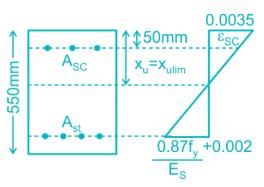

So,
Xu = Xulim
For Fe 500
Xulim = 0.46 d
d = effective depth of the beam = 550 mm
Xulim = 0.46 × 550 = 253 mm
d' = effective cover to compression reinforcement = 50 mm
Maximum strain in concrete at outermost compression reinforcement as per IS 456:2000 = 0.0035
Now from similar triangle,
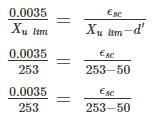
ϵsc = 0.00281

ϵsc = 0.00281
The percentage loss of prestress due to anchorage slip of 0.3 mm in a concrete beam of length 30 m which is post-tensioned by a tendon with initial stress of 1200 N/mm2 and modulus of elasticity equal to 2.1 × 105 N/mm2 is:- a)0.0175
- b)0.175
- c)1.75
- d)17.5
Correct answer is option 'B'. Can you explain this answer?
The percentage loss of prestress due to anchorage slip of 0.3 mm in a concrete beam of length 30 m which is post-tensioned by a tendon with initial stress of 1200 N/mm2 and modulus of elasticity equal to 2.1 × 105 N/mm2 is:
a)
0.0175
b)
0.175
c)
1.75
d)
17.5

|
Sreemoyee Chauhan answered |
Loss of prestress due to anchorage slip


= 2.1 N/mm2
% loss of prestress = 

An ordinary mild steel bar has been prestressed to working stress of 200 MPa. Young’s modulus of steel is 200 GPa. Permanent negative strain due to shrinkage and creep is 0.0008. How much is the effective stress left in steel?- a)184 MPa
- b)160 MPa
- c)40 MPa
- d)16 MPa
Correct answer is option 'C'. Can you explain this answer?
An ordinary mild steel bar has been prestressed to working stress of 200 MPa. Young’s modulus of steel is 200 GPa. Permanent negative strain due to shrinkage and creep is 0.0008. How much is the effective stress left in steel?
a)
184 MPa
b)
160 MPa
c)
40 MPa
d)
16 MPa

|
Anuj Chakraborty answered |

At limit state of collapse, an RC beam is subjected to flexural moment 200 kN.m, shear force 20 kN and torque 15 kN.m. The beam is 400 mm wide and 500 mm effective depth with 50 mm cover. The equivalent shear force and equivalent moment is :- a)80 KN and 226.95 KN.m
- b)80 KN and 220.95 KN.m
- c)70 KN and 320.95 KN.m
- d)70 KN and 226.95 KN.m
Correct answer is option 'B'. Can you explain this answer?
At limit state of collapse, an RC beam is subjected to flexural moment 200 kN.m, shear force 20 kN and torque 15 kN.m. The beam is 400 mm wide and 500 mm effective depth with 50 mm cover. The equivalent shear force and equivalent moment is :
a)
80 KN and 226.95 KN.m
b)
80 KN and 220.95 KN.m
c)
70 KN and 320.95 KN.m
d)
70 KN and 226.95 KN.m

|
Rohan Singh answered |
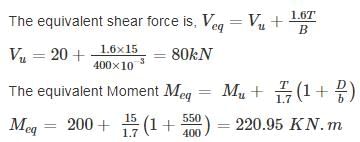
Which of the following losses of prestress occurs only in pre-tensioning and not in post-tensioning?- a)elastic shortening of concrete
- b)shrinkage of concrete
- c)creep of concrete
- d)loss due to friction
Correct answer is option 'A'. Can you explain this answer?
Which of the following losses of prestress occurs only in pre-tensioning and not in post-tensioning?
a)
elastic shortening of concrete
b)
shrinkage of concrete
c)
creep of concrete
d)
loss due to friction

|
Anuj Chakraborty answered |
Elastic shortening:
- Pre - Tensioning:
- When the prestress is transmitted to the concrete member, there is contraction due to prestress. This contraction causes a loss of stretch in the wire.
- Post - Tensioning:
- No loss due to elastic deformation if all the wires are simultaneously tensioned. If the wires are successively tensioned, there will be loss of prestress due to elastic deformation of concrete.
Elastic shortening occurs only in pre-tensioning and may not occur in post-tensioning if all wires are tightened at same point of time.
Consider the Exposure condition as "Concrete surfaces protected against weather or aggressive conditions, except those situated in coastal areas".As per IS 456:2000, The above exposure condition will correspond to:- a)Mild Exposure
- b)Moderate Exposure
- c)Severe Exposure
- d)Very Severe Exposure
Correct answer is option 'A'. Can you explain this answer?
Consider the Exposure condition as "Concrete surfaces protected against weather or aggressive conditions, except those situated in coastal areas".
As per IS 456:2000, The above exposure condition will correspond to:
a)
Mild Exposure
b)
Moderate Exposure
c)
Severe Exposure
d)
Very Severe Exposure

|
Puja Sharma answered |
As per clause 8.2.2.1, Table No 3 of IS 456:2000,


In accordance with IS 1343: 1980, in the absence of data, the approximate value of shrinkage strain for the design of post-tensioning concrete member if the age of concrete at transfer is 3 days will be?- a)2.86 × 10-4
- b)3 × 10-4
- c)3 × 10-3
- d)4.29 × 10-4
Correct answer is option 'A'. Can you explain this answer?
In accordance with IS 1343: 1980, in the absence of data, the approximate value of shrinkage strain for the design of post-tensioning concrete member if the age of concrete at transfer is 3 days will be?
a)
2.86 × 10-4
b)
3 × 10-4
c)
3 × 10-3
d)
4.29 × 10-4

|
Aditi Sarkar answered |
According to 1343: 1980, clause 5.2.4.1,
The approximate value of shrinkage strain for design shall be assumed as follows:
(i) For Pre-tensioning = 0.0003
For Post − tensioning =
For Post − tensioning =

For t = age of concrete at transfer (days)
At t = 3 days
Shrinkage strain will be:


A cantilever steel beam of 3 m span carries a uniformly distributed load of 20 kN/m inclusive of self-weight. The beam comprises ISLB200@198 N/m, flange 100 mm × 7.3 mm, web thickness 5.4 mm, Ixx = 1696.6 cm4, lyy = 115.4 cm4. Bending and shear stresses in the beam are respectively.- a)530.47 N/mm2 and 55.55 N/mm2
- b)3899.48 N/mm2 and 82.19 N/mm2
- c)132.62 N/mm2 and 27.78 N/mm2
- d)1949.74 N/mm2 and 41.10 N/mm2
Correct answer is option 'A'. Can you explain this answer?
A cantilever steel beam of 3 m span carries a uniformly distributed load of 20 kN/m inclusive of self-weight. The beam comprises ISLB200@198 N/m, flange 100 mm × 7.3 mm, web thickness 5.4 mm, Ixx = 1696.6 cm4, lyy = 115.4 cm4. Bending and shear stresses in the beam are respectively.
a)
530.47 N/mm2 and 55.55 N/mm2
b)
3899.48 N/mm2 and 82.19 N/mm2
c)
132.62 N/mm2 and 27.78 N/mm2
d)
1949.74 N/mm2 and 41.10 N/mm2

|
Saptarshi Khanna answered |
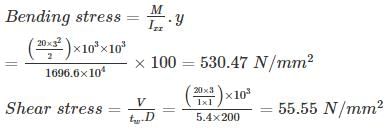
As per IS 456:2000, the diagonal tension failure in RCC beams depends upon:- a)Grade of concrete and Percentage of transverse reinforcement provided.
- b)Grade of concrete and Steel only
- c)Grade of steel and percentage of longitudinal reinforcement provided
- d)Grade of concrete and percentage of longitudinal reinforcement provided
Correct answer is option 'D'. Can you explain this answer?
As per IS 456:2000, the diagonal tension failure in RCC beams depends upon:
a)
Grade of concrete and Percentage of transverse reinforcement provided.
b)
Grade of concrete and Steel only
c)
Grade of steel and percentage of longitudinal reinforcement provided
d)
Grade of concrete and percentage of longitudinal reinforcement provided

|
Sahil Chawla answered |
According to Table No. 19 of IS 456:2000,
The allowable shear stress (design shear strength) depends on both percentage of longitudinal steel provided and grade of concrete used in the beam.
A square footing of side 4m is designed to support a square column of 400 mm size. The effective depth of footing is 500 mm. The safe bearing capacity below the footing is 1.5 MPa. The design bending moment for the footing is________- a)7920 KN-m
- b)900 KN-m
- c)9720 KN-m
- d)972 KN-m
Correct answer is option 'C'. Can you explain this answer?
A square footing of side 4m is designed to support a square column of 400 mm size. The effective depth of footing is 500 mm. The safe bearing capacity below the footing is 1.5 MPa. The design bending moment for the footing is________
a)
7920 KN-m
b)
900 KN-m
c)
9720 KN-m
d)
972 KN-m

|
Ashwin Gupta answered |
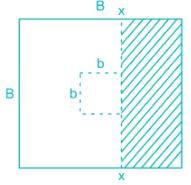
The critical section for bending moment is the face of the column:-
Po = Net upward pressure = 1.5 N/mm2

Beam sections designed in accordance with LSM as compared to sections designed in accordance with WSM will have- a)Larger depth and smaller amount of reinforcement
- b)Same depth and same reinforcement
- c)Smaller depth and more reinforcement
- d)Same depth as that of a deep beam
Correct answer is option 'C'. Can you explain this answer?
Beam sections designed in accordance with LSM as compared to sections designed in accordance with WSM will have
a)
Larger depth and smaller amount of reinforcement
b)
Same depth and same reinforcement
c)
Smaller depth and more reinforcement
d)
Same depth as that of a deep beam

|
Neha Mukherjee answered |
Balanced Sections designed on the basis of LSM give smaller depth or width (less concrete area) and more reinforcement than those designed with WSM.
For a two way simply supported RC slab of size 3 m × 9 m effective span. The maximum spacing of distribution bars satisfying codal provisions as per IS 456 : 2000 is?M-20 concrete and Fe-415 steel grade is used in the slab- a)300 mm
- b)428 mm
- c)322 mm
- d)450 mm
Correct answer is option 'D'. Can you explain this answer?
For a two way simply supported RC slab of size 3 m × 9 m effective span. The maximum spacing of distribution bars satisfying codal provisions as per IS 456 : 2000 is?
M-20 concrete and Fe-415 steel grade is used in the slab
a)
300 mm
b)
428 mm
c)
322 mm
d)
450 mm

|
Anuj Verma answered |
Maximum spacing of distribution bars in slab is = 5d or 450 mm (whichever is lesser)
d → effective depth of slab
A – value for simply supported slab for HYSD bars = 0.8 × 35 = 28


Use shorter span for calculation
3000/28 = deff
deff = 107.14 mm
Maximum spacing:
I. 5 × 107.14 = 535.7
II. 450 mm
Use lesser of above two
so, maximum spacing = 450 mm
As per IS 1343, The minimum clear spacing in case of single wires used in pre-tensioning system shall not be less than:- a)3 times the diameter of wire or 4/3 times the maximum size of aggregate, whichever is greater
- b)3 times the diameter of wire or 4/3 times the maximum size of aggregate, whichever is lesser
- c)2 times the diameter of wire or 4/3 times the maximum size of aggregate, whichever is greater
- d)2 times the diameter of wire or 4/3 times the maximum size of aggregate, whichever is lesser
Correct answer is option 'A'. Can you explain this answer?
As per IS 1343, The minimum clear spacing in case of single wires used in pre-tensioning system shall not be less than:
a)
3 times the diameter of wire or 4/3 times the maximum size of aggregate, whichever is greater
b)
3 times the diameter of wire or 4/3 times the maximum size of aggregate, whichever is lesser
c)
2 times the diameter of wire or 4/3 times the maximum size of aggregate, whichever is greater
d)
2 times the diameter of wire or 4/3 times the maximum size of aggregate, whichever is lesser

|
Kavya Mehta answered |
As per clause 11.1.7.1 of IS 1343,
In case of single wires used in pre-tensioning system, the minimum clear spacing shall not be lesser than greater of the following:
1) 3 times the diameter of wire, and
2)  times the maximum size of aggregate.
times the maximum size of aggregate.
 times the maximum size of aggregate.
times the maximum size of aggregate.A prestressed beam of size 250 × 400 mm deep is prestressed by 14 tendons of 6 mm diameter. The cable is located at 150 mm from the bottom of the beam. If the initial prestress in the beam is 1250 N/mm2. The loss of prestress due to elastic deformation and creep of concrete respectively will be?Assume:M-40 Grade concretecreep coefficient = 1.6Modulus of elasticity = 2 × 105 MPa.Neglect the effect due to dead load.- a)54.72 mPa and 87.55 MPa
- b)37.13 mPa and 59.42 MPa
- c)25.41 mPa and 40.65 MPa
- d)42.30 mPa and 55 MPa
Correct answer is option 'B'. Can you explain this answer?
A prestressed beam of size 250 × 400 mm deep is prestressed by 14 tendons of 6 mm diameter. The cable is located at 150 mm from the bottom of the beam. If the initial prestress in the beam is 1250 N/mm2. The loss of prestress due to elastic deformation and creep of concrete respectively will be?
Assume:
M-40 Grade concrete
creep coefficient = 1.6
Modulus of elasticity = 2 × 105 MPa.
Neglect the effect due to dead load.
a)
54.72 mPa and 87.55 MPa
b)
37.13 mPa and 59.42 MPa
c)
25.41 mPa and 40.65 MPa
d)
42.30 mPa and 55 MPa

|
Kavya Mehta answered |
Prestressing force (P) = 

Loss due to elastic shortening = mfc
fc = compressive stress at the level of steel
m = modular ration = Es/Ec
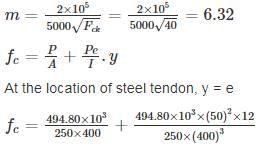

fc = 4.948 + 0.9277
fc = 5.876 MPa
loss due to elastic shortening = 6.32 × 5.876
= 37.13 MPa.
Loss due to creep of concrete = mϕfc
ϕ = creep coefficient = 1.6
loss due to creep of concrete = 6.32 × 1.6 × 5.876
= 59.42 MPa.
For footing, minimum cover should be- a)25 mm
- b)35 mm
- c)50 mm
- d)60 mm
Correct answer is option 'C'. Can you explain this answer?
For footing, minimum cover should be
a)
25 mm
b)
35 mm
c)
50 mm
d)
60 mm

|
Ashwin Gupta answered |
As per IS 456 : 2000 Clause number 26.4,
For nominal reinforcement.
For footings, minimum cover shall be 50 mm.
For a longitudinal reinforcing bar in a column nominal cover shall in any case not be less than 40 mm, or less than the diameter of such bar.
In the case of columns of minimum dimension of 200 mm or under, whose reinforcing bars do not exceed 12 mm, a nominal cover of 25 mm may be used.
As per IS: 456 in a two – way slab, the width of the middle strip along each span should be:- a)3/8 of the width of span in that direction
- b)3/8 of the width of the right angles
- c)3/4 of the shortest side of the slab
- d)3/4 of the width of the span in that direction
Correct answer is option 'D'. Can you explain this answer?
As per IS: 456 in a two – way slab, the width of the middle strip along each span should be:
a)
3/8 of the width of span in that direction
b)
3/8 of the width of the right angles
c)
3/4 of the shortest side of the slab
d)
3/4 of the width of the span in that direction

|
Anshul Kumar answered |
See figure


It is proposed to reduce 20 mm diameter bar to 16 mm diameter in an axially loaded column. Grade of steel used is Fe500. Which one of the following lap length should be used if the design bond stress for M25 grade concrete is 1.4 MPa.- a)384 mm
- b)621.43 mm
- c)480 mm
- d)1242.85 mm
Correct answer is option 'B'. Can you explain this answer?
It is proposed to reduce 20 mm diameter bar to 16 mm diameter in an axially loaded column. Grade of steel used is Fe500. Which one of the following lap length should be used if the design bond stress for M25 grade concrete is 1.4 MPa.
a)
384 mm
b)
621.43 mm
c)
480 mm
d)
1242.85 mm

|
Akshat Datta answered |
In compression zone,
Lap Length = Maximum of development length or 24 ϕ (where ϕ is the dia of smaller dia bar)
Development length, 



[60% increase in bond stress as HYSD bar]
25% increase in bond stress due to compression.
= 621.43 mm
Now 24ϕ = 24 × 16 = 384 mm
So the lap length should be 621.43 mm
An isolated footing of 2 m × 3 m along the plane of bending moment is provided under the column. If the net maximum and minimum pressure on the soil under the footing are 95 kN/m2 and 55 kN/m2 respectively and the axial load is 450 kN, then the bending moment at its base will be (The center of gravity of column and footing coincides)- a)60 kNm
- b)50 kNm
- c)70 kNm
- d)80 kNm
Correct answer is option 'A'. Can you explain this answer?
An isolated footing of 2 m × 3 m along the plane of bending moment is provided under the column. If the net maximum and minimum pressure on the soil under the footing are 95 kN/m2 and 55 kN/m2 respectively and the axial load is 450 kN, then the bending moment at its base will be (The center of gravity of column and footing coincides)
a)
60 kNm
b)
50 kNm
c)
70 kNm
d)
80 kNm

|
Siddharth Bajaj answered |
Area of footing = 2 × 3 = 6m2
Section modulus,

From (i) and (ii), we get

⇒ M = 60 kNm

From (i) and (ii), we get

⇒ M = 60 kNm
The nephron is: ....... ?- a)The site of urine storage
- b)The functional unit of the kidney
- c)The site where ADH is produced
- d)Also called the Bowman's capsule
Correct answer is option 'B'. Can you explain this answer?
a)
The site of urine storage
b)
The functional unit of the kidney
c)
The site where ADH is produced
d)
Also called the Bowman's capsule

|
Nclex Coaching Centre answered |
The nephron is:
The functional unit of the kidney.
Explanation:
The nephron is a small structure within the kidney that is responsible for filtering and processing blood to produce urine. It is considered the functional unit of the kidney because it performs all the essential tasks required for urine formation.
Key Points:
1. Structure: The nephron consists of several components, including the glomerulus, proximal convoluted tubule, loop of Henle, distal convoluted tubule, and collecting duct.
2. Filtration: The glomerulus, a network of tiny blood vessels, filters waste products, toxins, and excess water from the blood.
3. Reabsorption: The proximal convoluted tubule reabsorbs important substances such as glucose, amino acids, and electrolytes back into the bloodstream to maintain their balance.
4. Concentration: The loop of Henle plays a crucial role in concentrating urine by creating a concentration gradient within the kidney.
5. Regulation: The distal convoluted tubule adjusts the final composition of urine by selectively reabsorbing or secreting certain ions and substances.
6. Collection: The collecting duct collects the urine from multiple nephrons and transports it towards the renal pelvis for storage before it is excreted from the body.
Conclusion:
The nephron is the functional unit of the kidney responsible for filtering and processing blood to produce urine. Its various components work together to maintain the body's fluid and electrolyte balance.
The functional unit of the kidney.
Explanation:
The nephron is a small structure within the kidney that is responsible for filtering and processing blood to produce urine. It is considered the functional unit of the kidney because it performs all the essential tasks required for urine formation.
Key Points:
1. Structure: The nephron consists of several components, including the glomerulus, proximal convoluted tubule, loop of Henle, distal convoluted tubule, and collecting duct.
2. Filtration: The glomerulus, a network of tiny blood vessels, filters waste products, toxins, and excess water from the blood.
3. Reabsorption: The proximal convoluted tubule reabsorbs important substances such as glucose, amino acids, and electrolytes back into the bloodstream to maintain their balance.
4. Concentration: The loop of Henle plays a crucial role in concentrating urine by creating a concentration gradient within the kidney.
5. Regulation: The distal convoluted tubule adjusts the final composition of urine by selectively reabsorbing or secreting certain ions and substances.
6. Collection: The collecting duct collects the urine from multiple nephrons and transports it towards the renal pelvis for storage before it is excreted from the body.
Conclusion:
The nephron is the functional unit of the kidney responsible for filtering and processing blood to produce urine. Its various components work together to maintain the body's fluid and electrolyte balance.
The main reinforcement of an RC slab consists of 10 mm bars at 10 cm spacing. If it is desired to replace 10 mm bars by 16 mm bars, then the spacing of 16 mm bars should be- a)12 cm
- b)16 cm
- c)1 cm
- d)25.6 cm
Correct answer is option 'D'. Can you explain this answer?
The main reinforcement of an RC slab consists of 10 mm bars at 10 cm spacing. If it is desired to replace 10 mm bars by 16 mm bars, then the spacing of 16 mm bars should be
a)
12 cm
b)
16 cm
c)
1 cm
d)
25.6 cm

|
Gowri Sharma answered |
The horizontal distance between parallel main reinforcement bars shall not be more than three times the effective depth of solid slab or 300 mm whichever is smaller. The total reinforcement in the slab should remain same. By replacing 10 mm bars by 16 mm bars, the spacing will increase as


Match List – I (Post-tensioning system) with List – II (Arrangement of tendons in the duct) and select the correct answer using the codes given below the lists:List - IA. FreyssinteB. Gifford-UdallC. Lee-McCallD. Magnel-BlatonList – II1. Single bars2. Wires evenly spaced by perforated spacers3. Horizontal rows of four wires spaced by metal grills4. Wires spaced by helical wire core in annular spacer- a)A – 4, B – 1, C – 2, D – 3
- b)A – 3, B – 2, C – 1, D – 4
- c)A – 4, B – 2, C – 1, D – 3
- d)A – 3, B – 1, C – 2, D - 4
Correct answer is option 'C'. Can you explain this answer?
Match List – I (Post-tensioning system) with List – II (Arrangement of tendons in the duct) and select the correct answer using the codes given below the lists:
List - I
A. Freyssinte
B. Gifford-Udall
C. Lee-McCall
D. Magnel-Blaton
List – II
1. Single bars
2. Wires evenly spaced by perforated spacers
3. Horizontal rows of four wires spaced by metal grills
4. Wires spaced by helical wire core in annular spacer
a)
A – 4, B – 1, C – 2, D – 3
b)
A – 3, B – 2, C – 1, D – 4
c)
A – 4, B – 2, C – 1, D – 3
d)
A – 3, B – 1, C – 2, D - 4

|
Garima Basak answered |
In Freyssinet system, high tension steel wires 5 mm to 8 mm diameter about 12 in number are arranged to form a group into a cable with a spiral spring inside. In the Gifford Udall system the wires are stressed and anchored one by one in a separate cylinder using small wedging grips called Udall grips.
In the Lee-Mc Call system, high tensile alloy steel bars are used as the prestressing tends.
In the Magnel Blaton system cable of rectangular section is provided. The wires are arranged with four wires per layer. The geometric pattern of the wires is maintains in the same from throughout the length of the cable by providing grills or spacers at regular intervals.
An isolated T-beam used as the walking – way is shown in the figure. The clear span is 5m and fixed at both the ends. Calculated the effective flange width of the T-beam
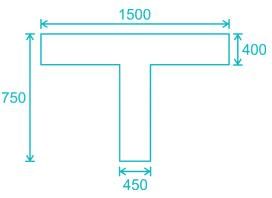
- a)726.31 mm
- b)1002.63 mm
- c)1131.81 mm
- d)790.90 mm
Correct answer is option 'B'. Can you explain this answer?
An isolated T-beam used as the walking – way is shown in the figure. The clear span is 5m and fixed at both the ends. Calculated the effective flange width of the T-beam


a)
726.31 mm
b)
1002.63 mm
c)
1131.81 mm
d)
790.90 mm

|
Sarthak Kulkarni answered |
effective length, lo = 0.7 × 5000 = 3500 mm
for isolated ‘T’ beam, effective flange width, 

where, b = 1500 mm
bw = width of the web = 450 mm
 + 450 = 1002.63mm
+ 450 = 1002.63mm
 + 450 = 1002.63mm
+ 450 = 1002.63mmThe appropriate expression in assessing development length is:- a)

- b)

- c)

- d)

Correct answer is option 'A'. Can you explain this answer?
The appropriate expression in assessing development length is:
a)

b)

c)

d)


|
Rohan Singh answered |
A development length is the amount of rebar length that is needed to be embedded or projected into concrete to create desired bond strength between the two materials and also to develop required stress in steel at that section. It is given by:


Chapter doubts & questions for RCC & Prestressed Concrete - RRB JE for Civil Engineering 2025 is part of Civil Engineering (CE) exam preparation. The chapters have been prepared according to the Civil Engineering (CE) exam syllabus. The Chapter doubts & questions, notes, tests & MCQs are made for Civil Engineering (CE) 2025 Exam. Find important definitions, questions, notes, meanings, examples, exercises, MCQs and online tests here.
Chapter doubts & questions of RCC & Prestressed Concrete - RRB JE for Civil Engineering in English & Hindi are available as part of Civil Engineering (CE) exam.
Download more important topics, notes, lectures and mock test series for Civil Engineering (CE) Exam by signing up for free.
RRB JE for Civil Engineering
2 docs|42 tests
|

Contact Support
Our team is online on weekdays between 10 AM - 7 PM
Typical reply within 3 hours
|
Free Exam Preparation
at your Fingertips!
Access Free Study Material - Test Series, Structured Courses, Free Videos & Study Notes and Prepare for Your Exam With Ease

 Join the 10M+ students on EduRev
Join the 10M+ students on EduRev
|

|
Create your account for free
OR
Forgot Password
OR
Signup to see your scores
go up
within 7 days!
within 7 days!
Takes less than 10 seconds to signup









